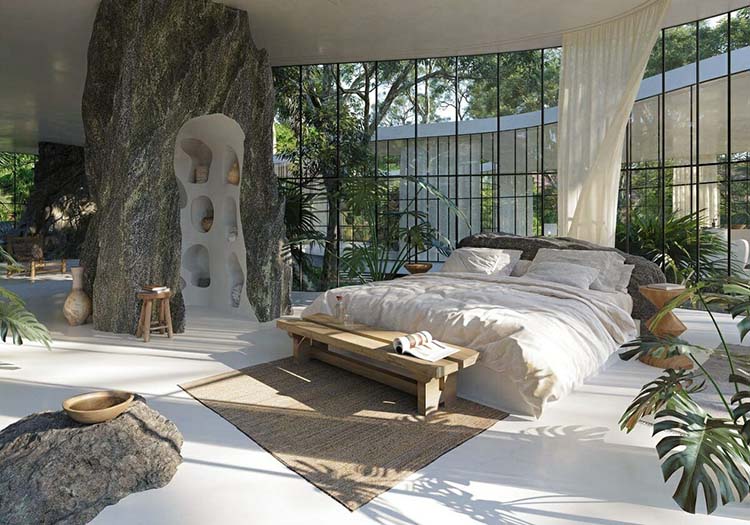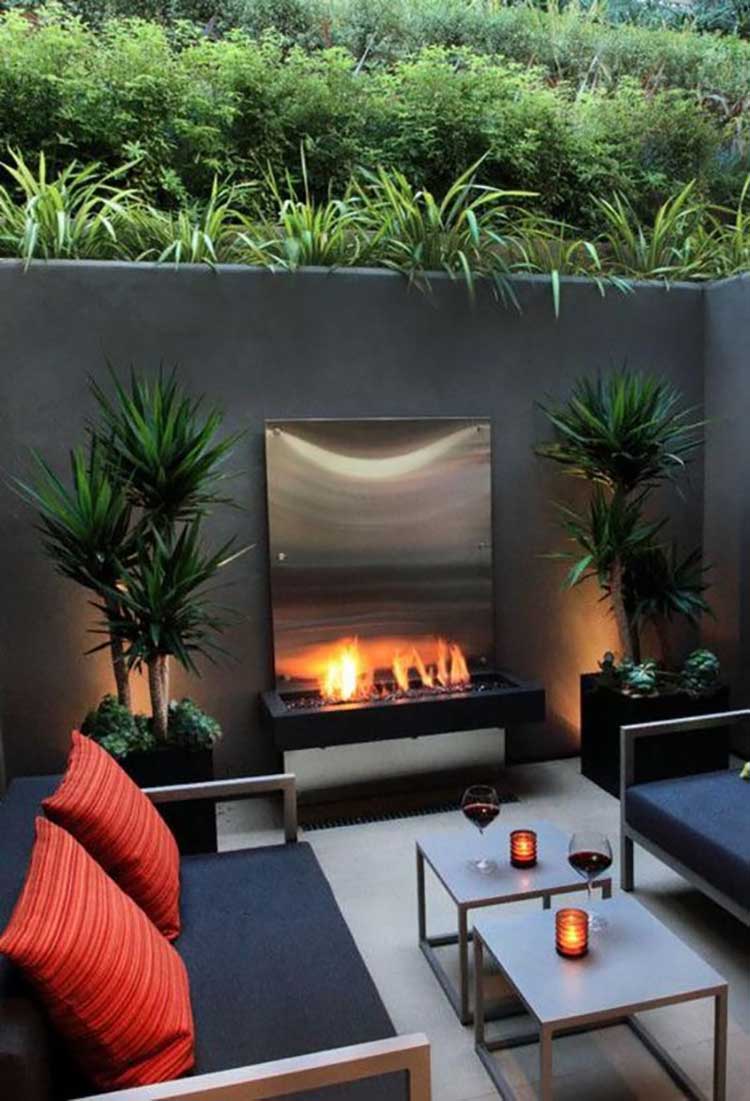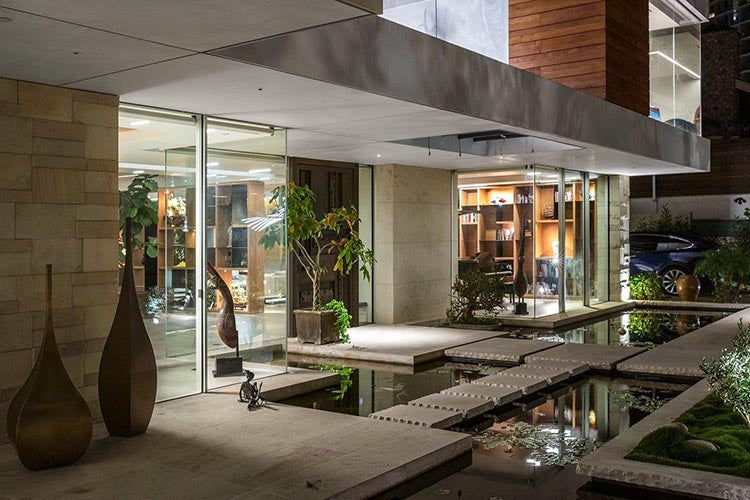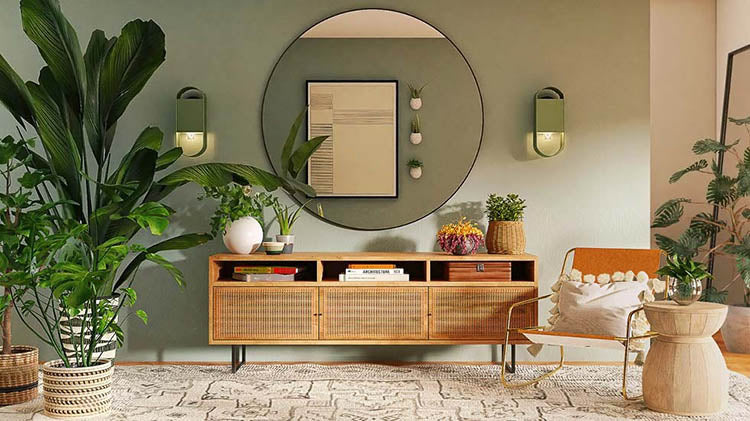Gifting has never been easier
Perfect if you're short on time or are unable to deliver your gift yourself. Enter your message and select when to send it.

Cart
Your cart is empty
As life becomes increasingly hectic and stressful, people are more inclined to seek ways to bring the tranquility and beauty of the natural world into their living spaces. One prime example of this is biophilic interior design.
So, what are the special benefits of this interior design approach, and what makes it worthy of praise? In this article, Rowabi will explore and provide insights into the unique advantages of biophilic interior design, as well as offer ideas for incorporating its elements into your home.
In this section, we will delve into the concept and significance of biophilic interior design, as well as its benefits for our lives and well-being.
Biophilic interior design brings nature into our indoor spaces to improve our health and well-being. The term "biophilia" means a love for nature, and this design approach uses elements like plants, natural patterns, sunlight, and fresh air it improve air quality, circulation, and overall human health by aligning with our innate connection to nature.

Biophilic interior design creates a natural sanctuary amidst the modern urban landscape. Source: Woodland Pulse (1)
Stephen Kellert and Edward O. Wilson were key figures in developing this concept. Wilson suggested in his 1984 book "Biophilia" that humans have an inherent need to connect with nature. Kellert expanded on this idea, describing biophilic design as a way to create beneficial interactions between people and nature in modern buildings and landscapes.
Biophilic design enhances our sensory experience by connecting us with nature visually, audibly, and physically, promoting both health and environmental sustainability. Architect Frank Lloyd Wright's famous quote, "Study nature, love nature, stay close to nature, it will never fail you," underscores the importance of designing spaces that harmonize with the natural world.
Among numerous interior design styles, biophilic interior design is one of the few that offers benefits for both physical and mental well-being. Here are some key advantages:
Incorporating natural elements such as plants, light, and water features into your home reduces cortisol levels, the body's primary stress hormone, resulting in decreased anxiety and enhanced tranquility. This creates a more relaxed atmosphere for both residents and visitors, fostering a sense of calm and emotional balance.
NASA-funded research (2), titled "Interior Landscape Plants for Indoor Air Pollution Abatement," has shown that incorporating plants into indoor spaces effectively reduces levels of indoor pollutants. Acting as natural air purifiers, plants filter out harmful substances such as volatile organic compounds (VOCs) and formaldehyde.
Additionally, plants contribute to maintaining optimal indoor humidity levels, resulting in a healthier and more comfortable environment. This reduction in indoor air pollution supports better respiratory health and overall well-being for occupants.
You may not be aware, but utilizing interior plants has been shown to significantly enhance productivity in both work and daily life, as revealed by statistics from Easy Office (18).
Approximately 70% of individuals surveyed report that incorporating plants improves the atmosphere at home and in the office. Moreover, a notable 31% indicate that the presence of greenery and plants directly contributes to their ability to concentrate while working.
Experiencing biophilic features in our daily environments, such as homes and offices, yields significant long-term health benefits. These include reducing blood pressure, supporting heart health, decreasing the risk of heart-related illnesses, and improving air quality to reduce respiratory issues like asthma and COPD.

Using biophilic interior design has more health benefits than people think. Source: Decorilla (3)
Exposure to natural light also regulates sleep patterns, promoting both physical and mental well-being. Moreover, integrating plants into office spaces has been found to enhance overall health and well-being.
Research from Easy Office shows that plants elevate air humidity, create a perception of comfortable temperature, and boost mood. A greener office environment can reduce sick days per person per year by up to 1.6 days.
There are six fundamental principles for crafting the most authentic biophilic interior design. We'll delve into each one to thoroughly analyze and understand them.

There are 6 principles of biophilic design in total. Source: LinkedIn (4)
Environmental features are essential in biophilic interior design, integrating natural elements for human well-being. Direct contact with vegetation is highly effective, creating green spaces with native plants, walking paths, and seating areas.
These environments promote relaxation, contemplation, and rejuvenation, aiming to alleviate stress, enhance comfort, uplift mood, and support healing, especially in healthcare settings.
Emphasizing the use of natural forms and patterns, biophilic design seeks to mimic the complexity found in natural environments, from the vast openness of the sky to the intricate patterns of a single leaf. In architectural detailing, organic shapes can be incorporated on multiple scales.
Large-scale ornamentation, curved edges, and natural materials in features like fireplace mantles connect to nature. Smaller details, such as patterned trim and intricate carving, add richness. Curves, soft edges, and patterns in furniture, textiles, and decor enhance the natural ambiance.
Incorporating natural patterns and processes mirrors the rhythms of nature, making spaces dynamic and vibrant. This involves integrating patterns like fractals and reflecting processes such as growth and aging into interior spaces.
Transitions, contrasts, and clear boundaries in building design foster a deeper connection with nature. Highlighting properties derived from nature, such as variations in sensory perceptions and changes in material qualities over time, contributes to a sense of completeness and unity in interior spaces, reflecting nature's beauty in human habitats.
The light and space principle of biophilic interior design highlight the importance of natural elements in connecting occupants with nature. Abundant natural light creates dynamic and sculptural forms in spaces.
Beyond just natural light, incorporating filtered and reflected light, along with the interplay of light and shade, adds visual interest and enhances sensory experiences. These varied lighting strategies, including shadows and diffused light, mimic outdoor conditions, improving mood, productivity, and circadian rhythms.
The place-based relationship principle in biophilic interior design aims to create a strong connection between a space and its geographical, cultural, and ecological context, avoiding the blandness of "placelessness."
This involves using local materials, native plants, and traditional building techniques, while also capturing the spirit of the place with elements like local art, historical references, and cultural motifs.
By embedding spaces in their unique contexts, designers create environments that reflect the natural and cultural identity of the place, enhancing human well-being and environmental sustainability.
The principle of evolved human-nature relationships in biophilic interior design highlights the deep connection between humans and nature, aiming to embody this connection in built spaces.
While all aspects of biophilic design reflect our bond with nature, this principle specifically aims to evoke fundamental sensations and emotions, such as safety, balance, curiosity, and awe. By replicating these natural sensations in design, individuals are encouraged to feel more responsible for the planet and develop a stronger connection with the natural world.
Integrating biophilic elements into your home doesn't have to be expensive. With some affordable and creative solutions, you can transform your living space into a natural oasis that enhances health, happiness, and productivity.
In biophilic interior design, a fundamental step is to incorporate natural elements like plants into your living space. You don't need a large garden to achieve this; a few potted plants on your balcony or strategically placed around your home can make a significant difference.

This not only helps purify the air but also enhances your overall well-being. Source: Blog Detail (5)
For beginners, starting with low-maintenance plants such as succulents, cacti, and air plants is an excellent way to get accustomed to plant care. These plants are easy to manage and thrive with minimal attention.
Incorporating biophilic design into your home isn't just about adding real plants; you can also infuse nature-inspired interiors to create a cohesive and soothing environment. Start by selecting artwork that features natural elements, such as landscapes, abstract interpretations of nature, or botanical prints.

Choose furniture pieces like sofas or chairs with curves and soft edges. Source: The Design Sheppard (6)
Additionally, enhance the natural feel of your interiors with soft furnishings. Opt for throw pillows and cushions with floral prints or plant motifs to add visual interest and a touch of nature. Choose fabrics that mimic the textures found in nature, such as linen, cotton, or wool, to create a cozy and inviting atmosphere.
You can create a cohesive, nature-inspired aesthetic by incorporating natural materials throughout your biophilic interior design home. Use wood, clay, cork, rattan, and wool for timeless character and personality. Add a jute or cotton rug for warmth and texture, and a stone side table as a striking accent.

Aurelia Rattan Pendant Light suits this interior design, with a blooming flower-like shape. Source: Rowabi
Additionally, a standout element to consider is a rattan pendant light. Rattan, with its intricate weaves and natural fibers, adds rustic charm while casting beautiful, organic patterns of light and shadow, enhancing your space's ambiance. Its lightweight and durable nature also makes it a sustainable and long-lasting choice.
In biophilic interior design, sunlight absorption offers significant benefits. According to research titled "Regular Sun Exposure Benefits Health (7)", an adequate amount of exposure to ultraviolet (UV) radiation from the sun can increase the production of serotonin. This hormone helps regulate your mood and also your sleep, appetite, digestion, learning ability, and memory.

Maximize sunlight in high-traffic areas like the living room or lounge. Source: DesignWanted (8)
To maximize natural light in your home, consider opting for blinds instead of curtains to allow more sunlight to filter through. Additionally, decluttering window sills and removing obstructions can optimize light penetration, further enhancing the positive effects of sunlight exposure on your well-being.
Enhancing ventilation is vital for ensuring a healthy indoor environment, especially within the context of biophilic interior design. One method is to regularly open windows and doors, even during colder weather, to allow fresh air to circulate throughout your home. This helps prevent the buildup of stale air and reduce indoor pollutants.
Another effective strategy is to install exhaust fans in areas prone to moisture, like the kitchen and bathroom. These fans help remove excess humidity, preventing the growth of mold and mildew. Additionally, incorporating indoor plants can further enhance ventilation and air purification by absorbing carbon dioxide and releasing oxygen.
Read more: [Update 2024] How Much Does It Cost to Install a Light Fixture?
Creating cozy nooks in your home is indeed a wonderful idea for relaxation and rejuvenation. You can consider incorporating a window seat with plush cushions and blankets, providing a cozy spot for reading or enjoying a cup of tea. Elevate the atmosphere with soothing scents, such as essential oils or candles, and personal touches like artwork or photos.
In biophilic interior design, achieving balance among various elements is essential, not just the greenery of plants. Integrating elements of fire adds warmth and ambiance to your living spaces.

The element of fire brings a cozy, harmonious feeling. Source: Foyr (9)
Besides traditional hearths, try modern options like bioethanol or electric fireplaces. Don't forget outdoor fire pits for gatherings. For a subtle touch, use candles or lanterns indoors for cozy vibes.
By incorporating water features into your home, you can enhance tranquility and create a deeper connection to nature. Consider installing a wall-mounted waterfall or a small indoor pond adorned with aquatic plants.

Creating ponds like these can serve as both fish tanks and house cooling features. Source: Whipple Russell Architects (10)
Moreover, you can elevate your bathroom experience by incorporating a rain shower or a Japanese-style soaking tub, transforming it into a serene spa-like retreat. Don't hesitate to experiment with different water feature designs to find the perfect fit for your space and lifestyle.
Decorating your space with images of nature can bring a sense of tranquility and connection to the outdoors. You might consider displaying landscape paintings that evoke serene scenes or hanging framed photographs that capture your outdoor adventures. Additionally, you can also use botanical prints featuring vibrant flowers or lush foliage as wallpapers to add texture.

This is also a great low-budget choice to add a touch of green. Source: MissPrint (11)
Embracing earthy color tones in your home can foster a sense of calm and connection to nature, a key aspect of biophilic interior design. To achieve this, you can use a palette of neutral or earthy tones, incorporating shades of brown, green, and blue in subtle ways.

Choose earthy tones for easy coordination and to complement indoor plants. Source: Woodland Pulse (12)
For instance, you can paint your walls in soft, muted greens or warm, sandy browns to create a serene backdrop. Complement these with furnishings in deeper shades, like a rich chocolate-brown sofa or olive-green armchairs, to add depth and warmth to your space.
Start by selecting furniture that features soft curves and abstract forms. For example, you can consider a round coffee table, a curved sofa, or an oval mirror. These items can add a unique, natural beauty to your living space. Asymmetrical shelves or a wavy headboard can also introduce a pleasing imperfection that feels both dramatic and organic.
To further develop this theme, you should incorporate decor items that reflect organic shapes. Look for decorative bowls with irregular edges, abstract sculptures, or freeform vases. Lighting fixtures with sculptural designs, such as pendant lights with flowing shapes, can also emphasize the organic aesthetic.
When decorating your home, consider moving away from the idea of perfectly matching furniture and instead embracing a variety of styles to create a more dynamic and personalized look.

Mix and match different materials and styles to create diversity. Source: House Digest (13)
For example, in your living room, mix different types of accent chairs—pair a vintage leather armchair with a modern, sleek recliner. In the dining area, opt for an assortment of dining chairs, such as combining rustic wooden chairs with contemporary metal ones.
To create visual interest and depth in your home decor, incorporate varying heights and scales. Instead of arranging items with uniform size and shape, consider playing with different heights to mimic the organic asymmetry found in nature.
For example, you can mix and match tall floor lamps with low-profile side tables or display a combination of tall vases, medium-sized sculptures, and small decorative objects on a shelving unit.
You can use a diverse range of textures, both visually and tactilely, to enrich your spaces with a biophilic design interior. Experiment with woven upholstery to add depth and warmth to furniture pieces.

Combining this texture with a woven texture in the same furniture piece always adds interest. Source: Architectural Digest India (14)
Complement these with smooth surfaces like polished wood or glass for contrast. You also consider elements with rough textures, such as exposed brick walls or textured fabrics, to create visual interest and evoke a sense of rugged natural beauty.
Building a biophilic interior design home includes embracing the beauty of aging and weathering by selecting items that develop a patina over time. Consider incorporating copper, brass, and bronze accents, which gradually develop a rich, warm patina, adding a sense of history and authenticity to your space.
Additionally, embrace the Wabi-Sabi concept by incorporating natural, organic, and handmade artworks into your decor. Choose pieces that show signs of wear and imperfections, celebrating the beauty of authenticity and the passage of time.
Ensuring ample space for air circulation is paramount in biophilic interior design. Arrange furniture strategically to establish clear pathways, allowing for easy movement throughout the space. For instance, position sofas and chairs to clearly define entrances and exits, facilitating smooth transitions between rooms.

Keeping pathways clear also helps with air circulation. Source: Interiors by Guernsey (15)
By prioritizing clear traffic flow, individuals can experience a sense of openness and comfort in their living environment, promoting positive energy flow throughout their biophilic interior design spaces.
When it comes to biophilic interior design, green is often the first color that comes to mind. From soft sage to vibrant emerald, exploring the diverse shades of green can evoke the tranquility of nature. You can paint accent walls in soothing hues of green or incorporate green furniture pieces to enhance the harmony of the room.

The color green is emblematic of biophilic interior design. Source: Architectural Digest India (16)
By incorporating these green elements into your design scheme, you can create a serene and revitalizing environment that mimics the restorative qualities of the outdoors.
Creating a natural sanctuary within your home by subtly referencing nature is truly wonderful. You can achieve this by incorporating organic shapes, flowing lines, and intricate patterns inspired by natural phenomena.
Use textiles adorned with leaf or floral motifs, hang artwork depicting serene landscapes or wildlife scenes, and install lighting fixtures that emulate a forest canopy’s gentle, dappled light. Why don't you try creating a natural space within your home that reflects your love for nature right now?
Moss walls, with their uniqueness, bring a dynamic and organic element to your biophilic interior design home. Unlike traditional walls, moss walls are alive, creating a connection to nature indoors and evoking the serene ambiance of lush forests and tranquil woodland settings.

Moss walls retain their vibrant color and texture without the need for ongoing care . Source: Sound Zero (17)
One of the most appealing aspects of moss walls is their low maintenance requirements. Unlike living plants, moss walls thrive without soil, watering, or direct sunlight, making them perfect for interior spaces with limited natural light.
Clay plasters, extending beyond the conventional materials of wood and stone often employed in interior design, endow walls with texture and visual intrigue while simultaneously furnishing functional advantages, such as the regulation of indoor humidity levels.
Similarly, cork floors present a distinctive alternative to traditional flooring materials like wood or stone. Renowned for their softness and resilience, cork floors deliver comfort underfoot and mitigate noise pollution, rendering them particularly well-suited for apartment dwellers or urban residents.
Advancements in technology are revolutionizing the integration of nature into our indoor spaces, offering innovative solutions such as virtual reality simulations and the use of natural materials like cork in affordable and stylish designs. These technological developments are reshaping the future of biophilic design.
By embracing nature-inspired designs and sustainable practices, we can reduce stress levels, conserve resources, and maximize natural light within our living environments. This holistic approach not only enhances aesthetic appeal but also fosters overall well-being and environmental stewardship.
What is biophilic design in interior design?
What are the 5 senses of biophilic design?
What are the three pillars of biophilic design?
What are the basic principles of biophilic design?
What is the psychology behind biophilic design?
What is the point of biophilic design?
What is an example of a biophilic design?
What are the psychological effects of biophilic design?
Who is a biophilic person?
Is biophilic design good for ADHD?
What is the aesthetic of biophilic design?
What is the biophilic philosophy?
Who invented biophilic design?
What is the theme of biophilic interior design?
What are the natural materials used in biophilic design?
In summary, as Rowabi has mentioned, in our ever more urbanized existence, biophilic interior design offers a tangible and effective means to reconnect with nature.
Embracing this design ethos allows us to craft interiors that not only exude beauty but also bolster our health, happiness, and overall sense of well-being.
Source:

How To Repair Rattan Furniture? The Ultimate Guide and Easy
Are there any tips for homeowners on how to repair rattan furniture that is damaged or older? The answer is yes. With a few tips and tools, you can renovate your furniture and make it look more con...
Read more
Modern Bohemian Interior Design: 15+ Amazing Ideas for 2024
In 2024, we see the rise of interior styles that blend and connect with each other to create a fresh and unique aesthetic, reflecting the homeowner's true self. If you're a free-spirited soul who e...
Read moreGifting has never been easier
Perfect if you're short on time or are unable to deliver your gift yourself. Enter your message and select when to send it.

Leave a comment
This site is protected by hCaptcha and the hCaptcha Privacy Policy and Terms of Service apply.